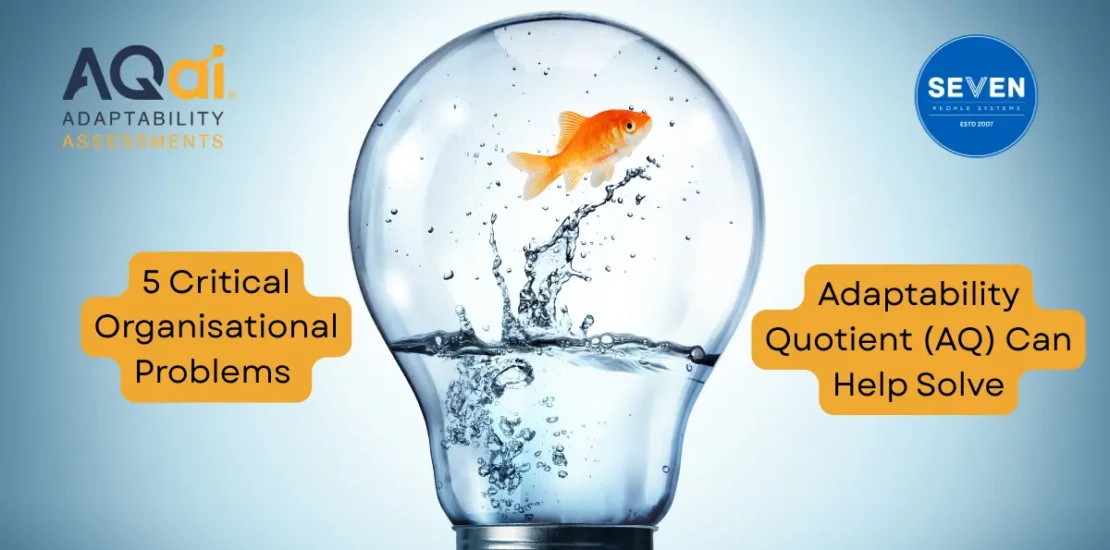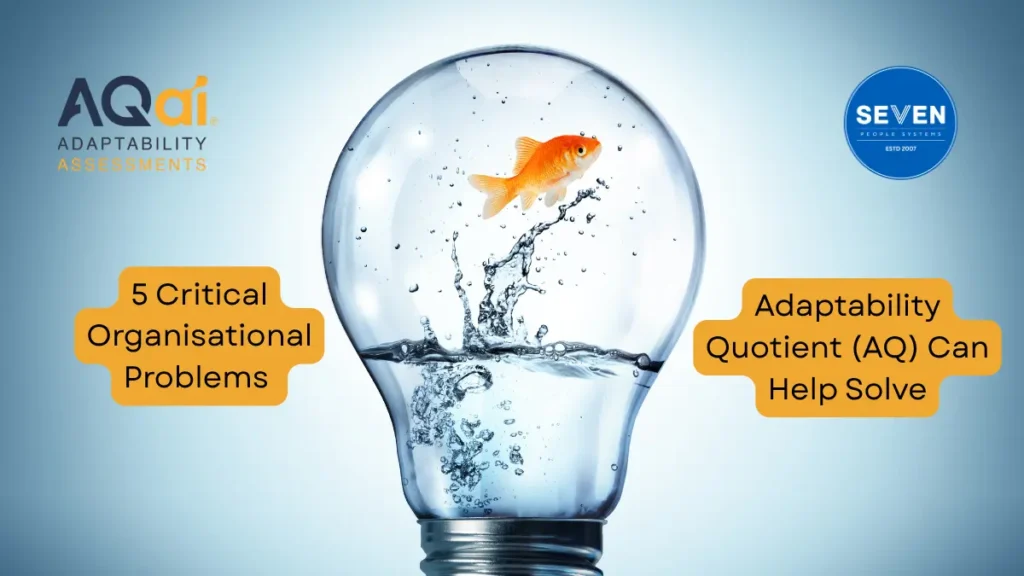5 Critical Organisational Problems Adaptability Quotient (AQ) Can Solve
- November 12, 2025
- Posted by: info@seven.net.in
- Category: Talent Management

Estimated reading time: 5 minutes
Table of contents
- Why Adaptability Quotient Defines Future-Ready Organizations
- 1. Resistance to Change: Turning Anxiety into Agility
- 2. Navigating Uncertainty: Building Clarity Amid Complexity
- 3. Shortened Skill Lifecycles: Creating Continuous Learners
- 4. Mental Rigidity and Burnout: Cultivating Psychological Resilience
- 5. Team Dysfunction and Poor Collaboration: Building Cohesion in Chaos
- The Ripple Effects of High AQ
- How to Build Adaptability in Your Organisation
- Future-Proof Your Workforce with Adaptability Quotient
- Interested in a bespoke workshop on AQ for your Leaders? Contact us.
Key Takeaways
- Adaptability Quotient (AQ) measures how well individuals and teams respond to change, making organizations more resilient and innovative.
- AQ helps address five critical problems: resistance to change, navigating uncertainty, shortened skill lifecycles, mental rigidity, and team dysfunction.
- High-AQ individuals foster a culture of curiosity, build mental flexibility, cultivate resilience, and enhance collaboration among teams.
- Organizations can develop AQ through assessments, learning pathways, leadership development, and team interventions.
- By embedding Adaptability Quotient (AQ) practices, companies create a resilient, future-ready workforce that embraces change as an advantage.

Why Adaptability Quotient Defines Future-Ready Organizations
The modern workplace is evolving faster than ever. Technological disruption, AI integration, and global uncertainty have forced organisations to rethink what drives long-term success. Traditional IQ and EQ alone no longer guarantee resilience or innovation.
That’s where the Adaptability Quotient (AQ) comes in. It measures how well individuals and teams respond to change, unlearn outdated behaviors, and evolve continuously. Organizations with high AQ don’t just survive disruption; they leverage it to grow stronger, more innovative, and future-ready.
Below are five critical organisational problems that AQ helps solve: each reshaping how teams lead, learn, and perform in a world that refuses to stand still.
1. Resistance to Change: Turning Anxiety into Agility
The Problem:
Many employees struggle with new technologies, evolving structures, or shifting business strategies. Resistance often stems from fear of failure, unclear communication, or attachment to old habits.
The AQ Solution:
High-AQ individuals thrive in change-rich environments. They unlearn old patterns, adopt new skills quickly, and remain emotionally balanced during transitions. By fostering a culture that values curiosity over control, organisations reduce fear and accelerate transformation.
Transition example: Instead of fearing change, adaptive employees see it as an invitation to grow.
2. Navigating Uncertainty: Building Clarity Amid Complexity
The Problem:
Unpredictable markets, hybrid work models, and rapid digitalisation create confusion and indecision. Uncertainty drains energy and paralyzes decision-making.
The AQ Solution:
Adaptability training develops mental flexibility and strategic calm under pressure. High-AQ teams don’t eliminate uncertainty—they navigate it with confidence. They use frameworks like scenario thinking and agile retrospectives to turn ambiguity into opportunity.
Transition example: When others freeze, adaptable teams find new routes forward.
3. Shortened Skill Lifecycles: Creating Continuous Learners
The Problem:
The average professional skill lifespan has dropped from 30 years to just 4.2 years. Many employees find themselves outdated before their next promotion.
The AQ Solution:
High-AQ individuals treat learning as a lifelong habit, not an occasional requirement. They continuously reskill, upskill, and pivot toward emerging needs. Organisations that invest in AQ-based learning cultures retain top talent and stay competitive in evolving industries.
Transition example: By integrating adaptability into performance reviews, companies encourage people to reinvent themselves regularly.
4. Mental Rigidity and Burnout: Cultivating Psychological Resilience
The Problem:
Fixed mindsets and constant change pressure lead to fatigue, disengagement, and burnout. Employees become reactive rather than reflective, lowering creativity and productivity.
The AQ Solution:
Adaptability Quotient strengthens the connection between resilience, emotional range, and mental flexibility. High-AQ teams learn to recover faster from setbacks, view challenges as growth opportunities, and regulate stress through awareness and self-management.
Transition example: When resilience meets adaptability, burnout turns into breakthrough.
5. Team Dysfunction and Poor Collaboration: Building Cohesion in Chaos
The Problem:
Cross-functional teams often clash in fast-moving environments. Misaligned goals, unclear communication, and cultural differences can derail collaboration.
The AQ Solution:
AQ fosters emotional intelligence, empathy, and collective motivation. Adaptive teams share a clear sense of purpose and learn to interpret feedback constructively. This psychological alignment enhances trust and accelerates execution, even when pressures mount.
Transition example: Teams with high AQ don’t avoid conflict—they harness it to create progress.
The Ripple Effects of High AQ
When adaptability becomes part of your organisation’s DNA, transformation accelerates naturally. The benefits extend far beyond individual capability.
1. Stronger Talent Retention
Adaptable employees are more engaged, purpose-driven, and loyal. They see change as progress rather than instability.
2. Faster Strategy Execution
Teams with high AQ absorb new systems and workflows with minimal disruption, turning transformation plans into measurable outcomes faster.
3. Resilient Organisational Culture
High-AQ workplaces replace fear with trust, control with curiosity, and burnout with balance. These cultures not only withstand turbulence—they thrive on it.
How to Build Adaptability in Your Organisation
Organisations can develop AQ systematically through:
- AQ Assessments: Measure adaptability capabilities across individuals and teams.
- Learning Pathways: Combine self-awareness, reflection, and skill-building modules.
- Leadership Development: Coach leaders to model flexibility, grit, and growth-oriented thinking.
- Team Interventions: Facilitate workshops on mindset agility, resilience, and collective learning.
By embedding AQ practices into your leadership programs and performance systems, you build an ecosystem that embraces change as a shared advantage.
Future-Proof Your Workforce with Adaptability Quotient
As the world continues to evolve, adaptability is no longer optional—it’s essential. The Adaptability Quotient (AQ) in the workplace acts as a compass, guiding people through uncertainty with clarity, creativity, and courage.
Whether your organisation faces transformation fatigue, innovation barriers, or leadership blind spots, AQ provides a science-backed roadmap to build resilient, future-ready teams.
Ready to discover your organization’s adaptability potential?
Book a Consultation for Organizational AQ Development and empower your people to thrive through change.
Interested in a bespoke workshop on AQ for your Leaders? Contact us.
- Phone India: +91.8104856725 | +91.9820222774
- Phone UAE: +971.552160708
- Email: info@seven.net.in
Explore Our Latest Posts
- 5 Simple Steps to Confident Personal Decision Making: A Complete Guide
- 5 Critical Organisational Problems Adaptability Quotient (AQ) Can Solve
- AI Training & Certification in India: The Complete 2025 Guide to 46 AI CERTs® Programs
- Adaptability Assessment in India: Why AQai is the Benchmark for Leaders and Teams
- How to Choose the Right AI Certification

